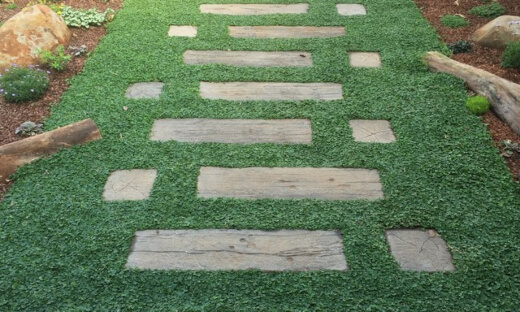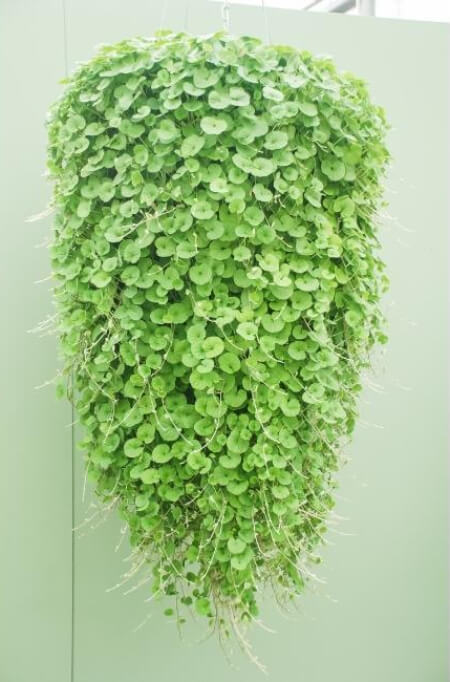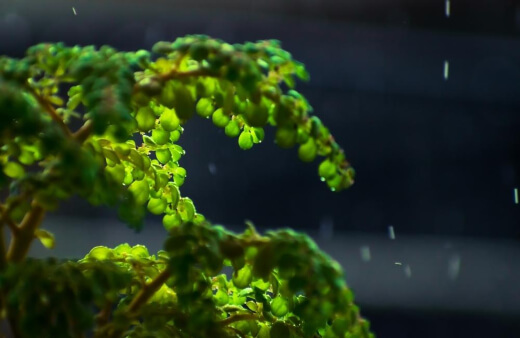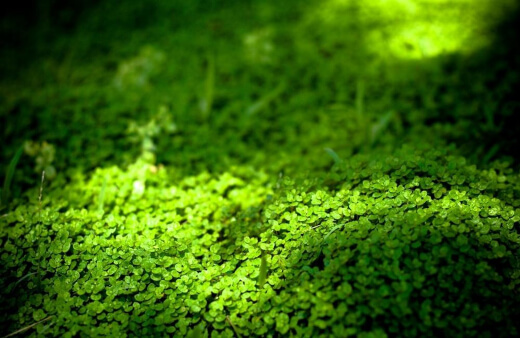With the ability to wander and weave itself seamlessly into gardens across Australia, the Dichondra repens is a must-have native plant.
Glistening with green flowing foliage that can be used in a variety of applications in gardens and other natural spaces, this herbaceous beauty is an excellent choice for growers who are looking for native alternatives for their gardens without the stress of high maintenance.
Here is your guide to growing and caring for your Dichondra repens.
More...
Genus: | Dichondra |
|---|---|
Species: | D. repens |
Family: | Convolvulaceae |
Common Names: | Kidney weed |
Location: | Outdoors |
Type: | Herbaceous plant, vine, ground cover |
Growth: | Height 10 to 30 centimetres / Width 1 to 5 metres |
Sun requirements: | Part shade to filtered sun |
Foliage Colour: | Green, yellow |
Flower Colour: | White (very small) |
Flowering: | Spring to summer |
Maintenance level: | Low |
Poisonous for pets: | Non-toxic to cats and dogs |
Dichondra repens Plant Details

Dichondra repens is a low-growing herbaceous plant that can be used almost anywhere in the garden and it naturally grows well in most parts of Australia.
This is why it has become so popular in households and is why growers are so keen on adding it to their collections. Providing this plant with the right growing conditions and care will ensure you have a thriving and healthy plant year-round.
Also known as Kidney Weed, this evergreen plant is native to Australia and New Zealand where it thrives in cool to temperate climates.
Some living in more tropical climates haven’t experienced as much success growing this native so there seems to be a fine balance when it comes to the optimal climate for this plant.
Like its non-native Dichondra counterparts, it forms a part of the Convolvulaceae family which is also known as the morning glory family. (Similar to Moonflowers.)
Growing to be around 10 to 30 centimetres high and 1 to 5 metres wide, this low-growing creeper plant is known to be fast-growing in its native habitat and relatively low-maintenance.
Identifiable by its dense mid to dark green foliage with leaves shaped like a kidney, the Dichondra repens can add luscious greenery that can complement any garden or natural space.
Kidney Weeds Landscaping Applications
There are some useful and attractive ways you can integrate this plant into your garden. Regardless of where you place it, it will always require certain conditions to thrive.
Here are some useful landscaping applications for Dichondra repens:

Source: houzz.com.au
Dichondra repens Ground Cover
Being a vigorous creeper that can form a dense mat, this plant is often used as native ground cover. Being planted underneath and around other natives in your garden beds will look fantastic. Plant 30 centimetres apart for use as ground cover.
Lawn Substitute
Again, due to the density and low-growing nature of Dichondra repens, it is also commonly used as a lawn substitute. It can offer a softer and more luscious effect on your lawn that won’t require as much mowing versus conventional grass.
It however can’t handle hard traffic so it should be used somewhere where light traffic is experienced. Plant 30 centimetres apart for use as a lawn substitute.
Outdoor Pot Plant
Potted into tall containers around the garden will allow this plant to present its natural flowing habit. As the leaves creep and spread, a flowing effect will occur from your pots which can add gorgeous texture to any garden.
Hanging Plant
Planted into hanging baskets outside will allow you to reap a dramatic cascading effect from your Dichondra repens. These backdrops can be used to add texture and a showy effect to your garden.
Other common uses include:
- Planting in between stepping stones
- Planted in cottage gardens or rockeries
How to Grow Dichondra repens

This native can be grown from seed or easily propagated using division.
Growing Dichondra repens from Seed
It is recommended to sow the seeds when daytime temperatures are around 21°C and the night temperatures are above 10°C. Sometime during spring is probably best.
To grow from seed:
- Prepare your planting site by ensuring the soil is loose and free of weeds.
- Scatter the seeds on the soil being sure that they are not covered by soil as the seeds will need light to germinate.
- Keep the soil lightly moist until germination starts which takes around 2 to 3 weeks.
Dichondra repens Propagation Using Division
This plant is easily propagated by division due to its vigorous creeping nature.
Follow these steps to propagate using division:
- Dig out a few stem pieces with roots attached from your donor plant.
- Using a sharp tool, cut these pieces away and replant them into your moist potting soil.
(Learn the importance of maintaining your gardening tools here.) - Keep the soil moist but not wet until the plant starts to show new growth.
- Thereafter, you can transplant it to your desired location.
Growing Dichondra repens
These plants can generally be planted any time of the year. Picking out the right spot in your garden is important to ensure the plant experiences healthy conditions to allow it to grow well and thrive once matured.
Here is what your Dichondra repens will need for its growing conditions:
Sunlight Preference
This plant will thrive with partial shade to filtered sun. It will also need protection from the afternoon sun. They can also grow in more shaded environments with dappled sunlight.
What Soil to Use
Dichondra repens grows best in soils that are well-draining and rich in organic matter. They enjoy moist soil so heavier clay or loamy soil types tend to work best.
Temperature & Humidity
Cool to warm temperate climates are best for this plant. Being a native, they should have no problem growing in most Australian climates.
How to Plant Dichondra repens

Now that you’ve picked out the perfect spot for your Dichondra repens, it’s time to plant it in its forever home.
Planting Kidney Weeds in the Garden
Choose a location with good drainage and one that receives the required light each day. You can prepare the soil by adding some compost and mixing it through. Be sure to remove any weeds from the area around your planting hole.
- Dig a hole that is twice as wide and to the same depth as the root ball.
- Gently remove the plant from its container and tousle the roots loose. You can cut away roots that are tangled.
- Position your plant in the hole and backfill with your soil and compost mix. Gently pat the soil firm.
- You can build a raised ring around your plant to help focus the water where it is needed most.
- Water well after planting to help settle the roots in the soil.
- As the plant establishes itself in the first couple of weeks, water two to three times per week depending on rainfall and soil moisture levels.
Planting Dichondra repens in a Pot
Choose a pot that is at least double the size of your plant. The location you place the pot in should get the right amount of light each day and the plant should still be protected from the afternoon sun.
- Fill your pot with the potting mix.
- Remove the plant from its container and gently tousle the roots loose. Cut away any tangled roots.
- Position the plant in your pot and backfill with soil. Gently pat the soil firm.
- Add an organic mulch around the base of the plant.
- Water two to three times per week to help the plant establish itself in the pot.
Dichondra repens Care Tips

Once matured, the Dichondra repens will be tough and won’t require too much hassle. It will tolerate light foot traffic and be frost and drought tolerant. Here are a few care tips to help your plant thrive.
Watering Dichondra repens
In the warmer months, you can water the plant regularly. When rain isn’t enough you can also water a little more frequently. In the cooler months, when the soil is dry to the touch, you can water the plant.
Generally, you should allow the soil to dry out slightly before watering again to prevent fungal problems.
What Fertiliser to Use
During spring you can add a general slow-release fertiliser to the soil to boost the nutrient content and assist the plant during its growing season.
Pruning
Pruning can also be done during spring to help the plant keep its shape. This could mean lightly pruning the plant every two to three weeks during this growing season. If used as a lawn alternative, you can follow the same template for mowing.
Pests, Problems & Diseases
Generally, Dichondra repens is a very healthy plant and doesn’t suffer from many pest issues or diseases. However, there are a few rare problems you could run into, including:
Root Rot & Fungal Diseases
These issues stem from overwatering. Should you notice brown leaf spots starting to form on your plant, this could indicate it has a fungal issue.
These spots can spread fast so as soon as you notice them, cut back on waterings and treat the plant with a general fungicide spray.
Flea Beetles
Flea beetles are pests that are known to feed on Dichondra. You can identify them by looking for small black to brown beetles that could also have stripes on their backs.
When disturbed, they use their large black legs to leap away. They can be treated by using an insecticide in severe cases. Healthy plants tend to be able to overcome these pest issues on their own.
Dichondra repens – Frequently Asked Questions

Is Dichondra repens invasive?
Due to their vigorous growing nature, these plants can develop invasive qualities in your landscape. Be sure to prune and cut back your plant to keep it shapely and tidy.
Does Dichondra have deep roots?
The root system is shallow, fibrous and can grow to a depth of 15 to 30 centimetres.
Does Dichondra attract bees?
During the summer months when Dichondra flowers, it could attract bees and other small insects. The flowers are small and insignificant.
Interested in other Australian lawn alternatives or need a little more help growing native plants? Be sure to check out our other informative articles here:

Enrich Your Garden with the Delicate Beauty of Dichondra repens
Being a vigorous native creeping plant that is easy going and fast-growing, the Dichondra repens is an excellent choice for growers who are looking for a tough native plant that can be used in a variety of landscaping applications.
Given the right amount of sun and placed in well-draining soil, the Dichondra repens will add year-round lusciousness to any garden.
Published on March 13, 2022 by Nathan Schwartz
Last Updated on February 26, 2024





Thanks for a terrific article on Dichondra. I'm aware that some natives are phosphorus sensitive but cannot find out if this applies to Dichondra. I've just purchased Dynamic Lifter and am wondering if I'll be able to scatter some on the Dichondra.
Kind regards
Graham